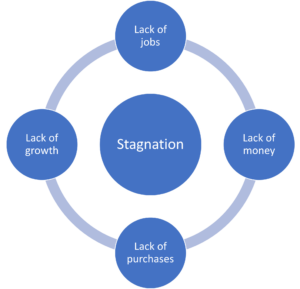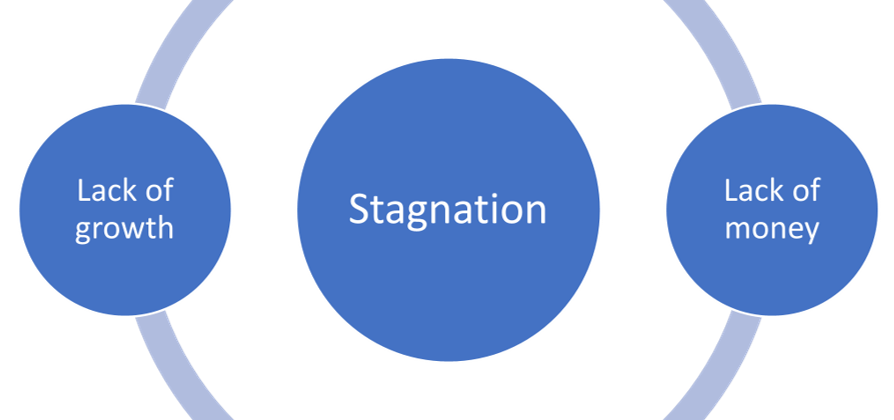The fifth in our series of seven key drivers influencing the move to After Capitalism is technology acceleration
Economic growth is slowing in part due to inability to pay.

The simple version of stagnation is a vicious circle (see figure): lack of jobs > lack of money > lack of purchases > lack of growth and back around. It presents a problem to the growth imperative of capitalism. Thus we are likely to see governments, businesses, and supporters of capitalism almost desperately try to make a case that everything is fine, and manipulate the numbers to say the growth is continuing (Aragao and Linsi, 2022). But digging into the question of whether growth is running into problems, there is evidence it has been for some time and is likely to continue into the future.
Recent history suggests that stagnation has been brewing for some time:
- Haque (2011) observed that business as usual hasn’t been able to create value over the last decade (the 2000’s).
- Reich (2013) notes the problem wasn’t too little saving, but too little demand; workers can’t afford the products they are making.
- Lanier (2013) suggested there eventually won’t be enough paying customers to subsidize all the free information.
- Aguilar-Milan (2014, 127) and colleagues highlighted that the “coming age of stagnation,” would be characterized by constraints on aggregate demand stimulus efforts not working.
- Piketty (2014) found that we are returning to a low-growth regime and signs are that growth will be even slower in the future.
- Frase (2016, 17) observed that the reason employers don’t hire more workers is because there aren’t enough people buying their products, because they don’t have enough money.
More recently
- Bastani (2019) sees our world is one increasingly defined by low growth, low productivity, and low wages.
- Roberts (2021) talks about a Long Depression since 1997.
- Benanav (2023) quips that economists are all stagnationists now.
And it could get worse. Three additional factors are the longer-term impact of automation, increasing debt load, the impact of aging, and potential life extension:
- Automation: Currently it is still mostly cheaper to hire people than to automate. But as that flips and jobs are lost, it strengthens the vicious circle above.
- Growing debt: The IMF noted that while the global debt situation has improved some since the Covid spike, the overall rising trend continues (Gaspar et al, 2023). Hudson (2016) speculates that he amount of debt will exceed the economy’s ability to produce a large enough surplus to pay it back, thus making a financial breakdown inevitable.
- Aging population: Bastani (2019) notes that by 2050 there will be more people over sixty-five than under fourteen – fewer workers to support more retirees. Older people also tend to live off savings rather than invest, which reinforces stagnation. A development in life extension would further exacerbate the situation by enlarging the size of the older cohort.
Stagnation suggests that capitalism’s growth imperative is running into trouble. The logic of capitalism is to constantly look for new things to commodify and sell. The problem is that it is becoming difficult to find these new things. A period of stagnation, therefore, is a big challenge to the continuation of capitalism. – Andy Hines
References
Aguilar-Millan, Stephen, Jason Swanson, Kate Burgess-MacIntosh, and Laura Schlehuber. 2014. “An Age of Stagnation?” World Futures Review 6(2), 120=129.
Bastani, Aaron. 2019. Fully Automated Luxury Communism. London: Verso.
Frase, Peter. 2016. Four Futures: Life after Capitalism. NY: Verso Brooks.
Gaspar, Vitor, Marcos Poplawski-Ribeiro, and Jiae Yoo. 2023. “Global Debt Is Returning to its Rising Trend.” IMF Blog, September 13, 2023, https://www.imf.org/en/Blogs/Articles/2023/09/13/global-debt-is-returning-to-its-rising-trend.
Haque, Umair. 2011. Betterness: Economics for Humans. Cambridge, MA: Harvard Business Review Press. Kindle Edition.
Hudson, Michael. 2016. “Fix our Debt Addiction to Fix our Economy.” Micheal-Hudson.com, April 20, 2016. http://michael-hudson.com/2016/04/fix-our-debt-addiction-to-fix-our-economy/.
Lanier, Jaron. 2013. Who Owns the Future? NY: Simon & Schuster.
Piketty, Thomas. 2014. Capital in the Twenty-First Century. Cambridge, MA: Belknap Press.
Reich, Robert. 2013. Aftershock: The Next Economy and America’s Future. NY: Vintage.
Roberts, Michael. 2021. “The US Rate of Profit in 2020.” Michael Roberts Blog, December 5, 2021, https://thenextrecession.wordpress.com/2021/12/05/the-us-rate-of-profit-in-2020/.

Too many holes in these arguments…